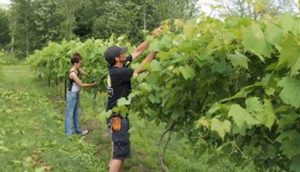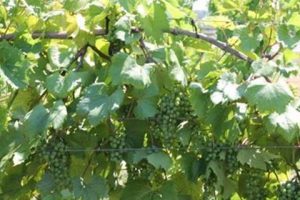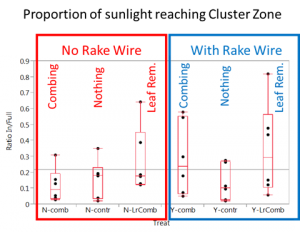http://northerngrapesproject.org/wp-content/uploads/2016/08/July-2016-News-You-Can-Use-canopy-mgmt-and-exposure.pdf

News You Can Use
Canopy Management and Light Interception
July 2016

Shoot tipping and basal leaf removal in Frontenac training systems trials in Clayton, NY.
(photo by T. Martinson).
Canopy management involves manipulation of vine growth to achieve production goals such as optimizing light interception, managing disease pressure, adjusting cropping levels or maximizing fruit quality. Site selection, grape variety, training system, soil fertility, and water management will all influence the amount of canopy management needed throughout the season. However, canopy management is labor intensive, so it is important to understand the costs and benefits associated with these practices. Mike White and Tim Martinson covered various canopy management practices, and the economics of them, in the February 2012 Webinar “Nuts and Bolts of Canopy Management.”
As canopy management affects light exposure to the clusters, this month we will also review the work being done in Clayton, NY, looking at the difference in fruit chemistry between shaded and exposed clusters of Marquette and Frontenac. In short, clusters exposed to sunlight have lower titratable acidity and higher soluble solids at harvest than clusters that are shaded. A research report from the Year 4 Northern Grapes Project Progress Report has complete details.
February 2012 Webinar “Nuts and Bolts of Canopy Management” http://youtu.be/eBGfmsSVJsM
Research Report “Impact of Shading on Frontenac & Marquette Fruit Composition” http://northerngrapesproject.org/wp-content/uploads/2016/02/NY-shaded-vs-exposed-Year-4.pdf
Additional Info: 2016 Preliminary Results. This year we are looking at ways to increase light interception by using a rake wire and “downward shoot positioning,” along with cluster-zone leaf removal, on high cordon-trained Frontenac at Clayton. The two-factor experiment involves:
1. Use of a rake wire to constrain canopy (Y or N)
2. Shoot combing and/or leaf removal in the cluster zone.

Rake Wire: Two moveable wires on each side of the canopy were used to constrain the canopy downward. They were at the top of the canopy at the start of the season and were moved down, with shoots tucked behind them, as the season progressed.
Last week we used a light meter to compare ambient light to the light reaching the cluster zone in this experiment. Preliminary results showed that shoot combing + the rake wire resulted in elevated light exposure – the range of values indicated by box plots below being similar to the “Rake Wire + Leaf Removal” treatment. Compare to the ‘no rake wire’ values at the left.
W
e will collect samples to compare fruit composition under these treatments this fall.
The Northern Grapes Project is funded by the USDA’s Specialty Crops Research Initiative Program of the National Institute for Food and Agriculture, Project #2011-51181-30850
Chrislyn A. Particka, PhD
Extension Support Specialist
Cornell University
School of Integrative Plant Science, Horticulture Section
630 W. North Street
Geneva, NY 14456
cap297
www.northerngrapesproject.org





